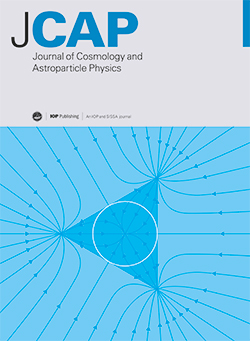A minimal axio-dilaton dark sector
IF 5.9
2区 物理与天体物理
Q1 ASTRONOMY & ASTROPHYSICS
Journal of Cosmology and Astroparticle Physics
Pub Date : 2025-07-08
DOI:10.1088/1475-7516/2025/07/023
引用次数: 0
Abstract
In scalar-tensor theories it is the two-derivative sigma-model interactions that like to compete at low energies with the two-derivative interactions of General Relativity (GR) — at least once the dangerous zero-derivative terms of the scalar potential are suppressed (such as by a shift symmetry). But nontrivial two-derivative interactions require at least two scalars to exist and so never arise in the single-scalar models most commonly explored. Axio-dilaton models provide a well-motivated minimal class of models for which these self-interactions can be explored. We review this class of models and investigate whether these minimal two fields can suffice to describe both Dark Matter and Dark Energy. We find that they can — the axion is the Dark Matter and the dilaton is the Dark Energy — and that they robustly predict several new phenomena for the CMB and structure formation that can be sought in observations. These include specific types of Dark Energy evolution and small space- and time-dependent changes to particle masses post-recombination that alter the Integrated Sachs-Wolfe effect, cause small changes to structure growth and more.最小轴膨胀暗扇区
在标量张量理论中,二阶导数西格玛模型相互作用喜欢在低能量下与广义相对论(GR)的二阶导数相互作用竞争——至少一旦标量势的危险零导数项被抑制(例如通过移位对称)。但是非平凡的二阶导数相互作用需要至少两个标量存在,因此在最常探索的单标量模型中从未出现过。Axio-dilaton模型提供了一个动机良好的最小模型类,可以探索这些自相互作用。我们回顾了这类模型,并研究了这两个最小场是否足以描述暗物质和暗能量。我们发现它们可以——轴子是暗物质,膨胀子是暗能量——它们有力地预测了宇宙微波背景的几种新现象,以及可以在观测中寻找的结构形成。其中包括特定类型的暗能量演化和重组后粒子质量的时空变化,这些变化会改变综合萨克斯-沃尔夫效应,导致结构增长等方面的微小变化。
本文章由计算机程序翻译,如有差异,请以英文原文为准。
求助全文
约1分钟内获得全文
求助全文
来源期刊

Journal of Cosmology and Astroparticle Physics
地学天文-天文与天体物理
CiteScore
10.20
自引率
23.40%
发文量
632
审稿时长
1 months
期刊介绍:
Journal of Cosmology and Astroparticle Physics (JCAP) encompasses theoretical, observational and experimental areas as well as computation and simulation. The journal covers the latest developments in the theory of all fundamental interactions and their cosmological implications (e.g. M-theory and cosmology, brane cosmology). JCAP''s coverage also includes topics such as formation, dynamics and clustering of galaxies, pre-galactic star formation, x-ray astronomy, radio astronomy, gravitational lensing, active galactic nuclei, intergalactic and interstellar matter.
 求助内容:
求助内容: 应助结果提醒方式:
应助结果提醒方式:


